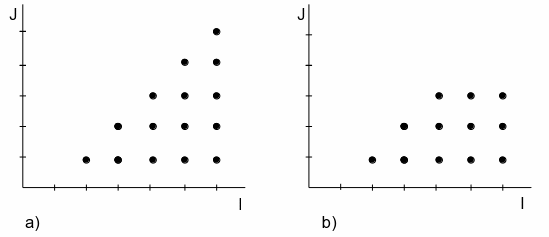Parallel Programming WS 2014/2015 - Assignment 5
Kastens, PfahlerInstitut für Informatik, Fakultät für Elektrotechnik, Informatik und Mathematik, Universität Paderborn
Jan 05, 2015
Exercise 1 (Iteration Spaces)
Determine the loops which have the following iteration spaces:

Exercise 2 ( Loop Permutation)
for I = 1 to 6 do
for J = 1 to 5 do
A[I, J] = A[I - 1, J - 2] + 1
endfor
endfor
- a)
- Determine the dependence vector.
- b)
- Can we permute the I and J loops?
- c)
- Show that we cannot permute the I and J loops of the following loop nest:
for I = 1 to N do for J = 1 to N do B[I, J] = B[I - 1, J + 1] + 1 endfor endfor
Exercise 3 ( Loop Reversal)
- a)
- Can we reverse the following loop?
for I = 1 to 6 do B[I] = B[I - 1] + 1 endfor - b)
- Can we reverse the J loop?
for I = 1 to 5 do for J = 1 to 6 do A[I, J] = A[I - 1, J - 1] + 1 endfor endfor
Exercise 4 ( Loop Skewing)
Original loop:
for I = 1 to 3 do
for J = 1 to 3 do
A[I, J] = A[I - 1, J + 1] + 1
endfor
endfor
- a)
- Draw the iteration space including a dependence vector.
- b)
- Why is it illegal to permute the I and J loops?
- c)
- Apply a skewing transformation with factor 1.
- d)
- Draw the resulting iteration space including a dependence vector.
- e)
- Permute the I and J loops of the resulting code. Is this a legal transformation?
- f)
- Draw the resulting iteration space including a dependence vector.
- g)
- Derive the loop bounds of the transformed loop from the drawing.
- h)
- Homework: Derive the loop bounds mathematically using the transformation matrix.
Exercise 5 (Homework: Transformation and Parallelization of a Loop)
Apply the transformation steps outlined on Slide 56c to parallelize the loop
for I = 0 to N do
for J = 0 to M do
A[I + 1, J] = A[I, J - 1] + A[I + 1, J - 2]
endfor
endfor
These are the necessary steps:
- 1. Draw the iteration space.
- 2. Compute the dependence vectors and draw examples of them into the iteration space.
- 3. Apply a skewing transformation with factor 1 and draw the iteration space.
- 4. Apply a permutation transformation and draw the iteration space.
- 5. Compute the matrix of the composed transformation and use it to transform the dependence vectors.
- 6. Compute the inverse of the transformation matrix and use it to transform the index expressions.
- 7. Specify the loop bounds by inequalities and transform them by the inverse of the transformation matrix.
- 8. Write the complete loops with new loop variables ip and jp and new loop bounds.
s00: A[1, 0] = A[0, -1] + A[1, -2] s01: A[1, 1] = A[0, 0] + A[1, -1] s02: A[1, 2] = A[0, 1] + A[1, 0] s10: A[2, 0] = A[1, -1] + A[2, -2] s11: A[2, 1] = A[1, 0] + A[2, -1] s12: A[2, 2] = A[1, 1] + A[2, 0] s20: A[3, 0] = A[2, -1] + A[3, -2] s21: A[3, 1] = A[2, 0] + A[3, -1] s22: A[3, 2] = A[2, 1] + A[3, 0]Compare this to your transformed version. Verify that the inner loop can be executed in parallel.
Generiert mit Camelot | Probleme mit Camelot? | Geändert am: 19.01.2015


